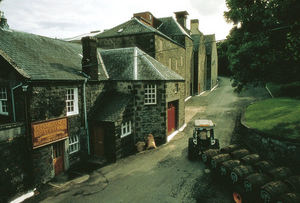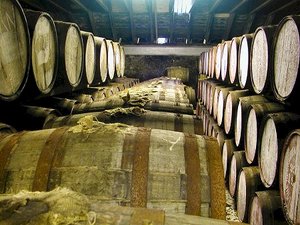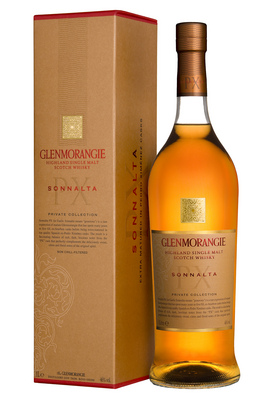|
|
Release Notes
This Glenmorangie Sonnalta PX is the second of the distillery's Private Collection bottlings after 2008's release of Astar. Sonnalta PX has been finished in casks formerly containing Pedro Ximenez, a deliciously rich, sweet sherry. A great success at a recent TWE tasting in Vinopolis.
The Whisky Exchange
Sonnalta means 'generous' in Gaelic (but of course you all knew that?) and this is a deliciously easy drinking Glenmorangie. We felt the Pedro Ximinez element wasn't especially pronounced but that hardly matters, as its a lovely whisky.
Royal Mile Whiskies
Having spent 10 long years maturing in American white oak casks this whisky is transferred into Spanish ex-Pedro Ximenez (PX) casks for its final two years of extra-maturation. Often described as the 'king of sherry casks' this rare wood was brought back from Jerez in Spain by our head of whisky creation Dr Bill Lumsden. Safely back in Tain it can then begin to weave its magic into Glenmorangie Sonnalta PX, adding the famous sweetness and intensity of the cask's previous resident.
Glenmorangie Sonnalta PX is the first release in our prestigious Private Edition range: carefully selected, limited edition whiskies chosen from the 'cabinet of curiosities' of Dr Bill Lumsden, head of our Whisky Creation Team.
Glenmorangie
3rd Party Tasting Notes
Aroma: Chocolate-coated raisins, smothered in treacle with a sprinkling of demerara sugar. Further aromas emerge including ginger, toasted almonds and vanilla.:
Taste: A sweet and fruity flavour progressing into a thick and syrupy pudding with a sprinkling of ginger and cinnamon.
Finish: Long and rich to the end with treacle toffee, sun-dried raisins and syrupy prunes.
Colour: Deepest gold
Taste: A sweet and fruity flavour progressing into a thick and syrupy pudding with a sprinkling of ginger and cinnamon.
Finish: Long and rich to the end with treacle toffee, sun-dried raisins and syrupy prunes.
Colour: Deepest gold
Glenmorangie
A version for travel retail.:
Colour: apricot.
Nose: starts rich, fragrant and not excessively winey, with loads of oranges and figs and just touches of gunpowder. Rather clean, it develops more on sultanas and roasted nuts (pecans), with hints of peonies and a faint sourness from the wine. Also hints of bananas flambéed and a wee grassiness in the background (banana skin). Works pretty well but the wine's influence is obvious. After a few minutes: gets fresher and even a little coastal but there's also a lot of caramel.
Mouth: very heavy now and extremely unusual. A coffee and raspberry liqueur mix? It's not bad at all but doesn't quite taste like whisky in my opinion. Goes on with notes of kiwis and tangerines, then more coffee again (or rather coffee liqueur such as Tia Maria or Kalhua). Really unusual.
Finish: long, roasted and zesty at the same time. Lemon and coffee flavoured chocolate? More sultanas.
Comments: did I already tell you this was unusual? More a cocktail than malt whisky but very good it is.
Rating: 82 points.
Colour: apricot.
Nose: starts rich, fragrant and not excessively winey, with loads of oranges and figs and just touches of gunpowder. Rather clean, it develops more on sultanas and roasted nuts (pecans), with hints of peonies and a faint sourness from the wine. Also hints of bananas flambéed and a wee grassiness in the background (banana skin). Works pretty well but the wine's influence is obvious. After a few minutes: gets fresher and even a little coastal but there's also a lot of caramel.
Mouth: very heavy now and extremely unusual. A coffee and raspberry liqueur mix? It's not bad at all but doesn't quite taste like whisky in my opinion. Goes on with notes of kiwis and tangerines, then more coffee again (or rather coffee liqueur such as Tia Maria or Kalhua). Really unusual.
Finish: long, roasted and zesty at the same time. Lemon and coffee flavoured chocolate? More sultanas.
Comments: did I already tell you this was unusual? More a cocktail than malt whisky but very good it is.
Rating: 82 points.
Whisky Fun
The Distillery: Glenmorangie
| Established: 1843 |
| Silent since: False |
| Address: Glen Morangie, Tain, Ross-Shire IV19 1PZ, United Kingdom |
| → website |
The Glenmorangie distillery in the Northern Highlands of Scotland can be credited with the popularisation of the idea of "finished malt whisky" - although I"m not sure if they were also the first to apply the technique of double maturation in another cask. Around 1995 Glenmorangie released three different " wood finishes" - a Port Finish, a Madeira Finish and a Sherry Finish. Later on some more finished "limited releases" were bottled.
2009 - Glenmorangie distillery is closed altogether in October 2008 so that two pairs of brand new stills can be added to the eight that were already in use. When the doors of the distillery are opened again in March 2009, the production capacity has increased from 4,000,000 litres of alcohol per year to 6,000,000 litres of alcohol per year. Mind you; this is the MAXIMUM capacity - due to the reconstruction and credit crisis actual production is lower.
2008 - Owners LVMH sell Glenmorangie"s "sister distillery" Glen Moray to La Martiniquaise. LVMH has little interest in whisky production itself and wants to focus on building the brands "Ardbeg" and "Glenmorangie".
Production-wise, a lot has changed at Glenmorangie over the years. For one thing, the number of stills was expanded from two to four in 1980, which was also the time they stopped malting their own barley. Glenmorangie managed to survive the whisky crisis of the early 1980"s with flying colours; in 1990 the number of stills was expanded again to a grand total of eight stills.
Those eight stills enable Glenmorangie to produce a whopping four million litres of pure alcohol each year. For a long time a lot of the malt whisky they produced was consumed within Scotland, but now it"s a world wide brand .
But of course, Glenmorangie is more than the premier purveyor of "finished" whiskies in Scotland. Their history started not unlike many of its Scottish competitors - in the nineteenth century. Not far from the site of the Balblair distillery (founded half a century earlier in 1790) William and John Mathesen built the "Morangie" farm distillery in 1843. William had been one of the co-owners of Balblair but apparently he wanted to strike out on his own. The Mathesen brothers selected a site with a long history of illicit distillation; there are claims about whisky distillation in the area as far back as 1738 and even 1703. However, actual production of malt whisky at Glenmorangie didn"t start until November 1849.
In 1887 the Glenmorangie Distillery Company Ltd. was founded and the distillery was rebuilt. In 1918 the distillery was sold to 2 partners; MacDonald & Muir Ltd. and Durham - circa two decades later MacDonald & Muir became full owners. Somewhere along the way, the name of the parent company was changed to Glenmorangie plc by the MacDonald family. They decided to sell the company (that also owned the Ardbeg and Glen Moray distilleries) to LVMH in 2004.

For a few years Glenmorangie was virtually the only malt whisky distillery to use "deviant" casks for the maturation of their stocks, but around the year 2000 more and more whisky distilleries in Scotland started to experiment with unusual casks that had no place in the whisky tradition.
Particularly Bruichladdich and Edradour turned into radical finishing freaks, taking the concept of double maturation further than Glenmorangie ever did. Personally, I prefer some of these "finishes" to the regular product...
During the 1990"s Glenmorangie was one of the few malt whisky distilleries with a well oiled marketing machine behind them, like Glenfiddich, Glenlivet, Springbank and the Classic Malts.
For my own tastes the PR language sometimes was a tad too oily, but you can"t argue with the numbers; Glenmorangie is now a top selling malt.
2004 - Glenmorangie buys the Scotch Malt Whisky Society. Furthermore, on August 24, 2004 the MacDonald family put their majority share of Glenmorangie Group plc on the market. Within the whisky industry, many expected that Brown Forman (owner of brands like Jack Daniels, Woodford Reserve and Southern Comfort) would expand its minority share, but perfume peddlers Louis Vuitton Moet Hennessey took over the company and its three distilleries instead.
2007 - The entire range of official Glenmorangie bottlings is revised. The old 10yo is replaced by the 10yo "Original" and parts of the range are discontinued. This includes the 15yo, the 30yo (which had just been introduced in 2005) and many of the more exotic finishes. The varieties "Astar" and "Signet" are introduced not long afterwards.
After the success the "mother brand" had with finishes, "daughter distillery" Glen Moray started to release their own finishes as well around the year 2000. For me personally, these didn"t work as well as the Glenmorangie finishes. While the fairly clean and subtle regular 10-12yo whisky from Glenmorangie benefited from the extra maturation, the fuller Speyside malts from Glen Moray lost some of their "edge" after weird finishes like Chardonnay or Chenin Blanc.

For my own tastes the PR language sometimes was a tad too oily, but you can"t argue with the numbers; Glenmorangie is now a top selling malt.
But is it any good? Well, the "house style" of most of the regular line-up is a tad light for my own tastes, but for "brand" blend drinkers it is a perfect "gateway malt" - a strong brand they can stick to with a couple of interesting expressions that could lead them to new malty discoveries later on.
As for the finishes: they seem to have a hard time achieving batch consistency, so buying a bottle is Russian roulette... Glenmorangie whisky Glenmorangie distillery in the new millennium
But is it any good? Well, the "house style" of most of the regular line-up is a tad light for my own tastes, but for "brand" blend drinkers it is a perfect "gateway malt" - a strong brand they can stick to with a couple of interesting expressions that could lead them to new malty discoveries later on.
As for the finishes: they seem to have a hard time achieving batch consistency, so buying a bottle is Russian roulette...
After the success the "mother brand" had with finishes, "daughter distillery" Glen Moray started to release their own finishes as well around the year 2000. For me personally, these didn"t work as well as the Glenmorangie finishes. While the fairly clean and subtle regular 10-12yo whisky from Glenmorangie benefited from the extra maturation, the fuller Speyside malts from Glen Moray lost some of their "edge" after weird finishes like Chardonnay or Chenin Blanc.
In the new Millenium
Trivia:
- At a height of more than 16 feet (5 m.), Glenmorangie has the tallest pot stills in the Scotch whisky industry. The original pair was expanded to four in 1980, and doubled again to eight in 1990. A further expansion to a grand total of twelve stills occurred in 2008 and 2009. All stills ore close replica"s from the stills that were built in 1887.
- The Glenmorangie distillery used to be a brewery before the distillery was founded.
- An unusually high percentage of the whisky that is distilled at Glenmorangie is sold as a single malt. Circa 70% of the whisky is bottled as SMSW; the rest was used in blends like Bailie Nicol Jarvie & Highland Queen. The very small percentage of malt whisky that is sold to brokers and bottlers used to be diluted with a few drops of Glen Moray (so it can"t be sold on as a single malt) and labeled as "West Port whisky".
- Glenmorangie has proven that it"s possible to increase sales considerably while decreasing "quality". Since the early 1990"s the profile of the regular expressions had been growing blander and blander, but the changes happened at an even more rapid pace after perfume peddlers Louis Vuitton MH obtained the distillery.
- The name of the whisky is pronounced glen-MOR-an-jee, with the stress on the "mor" and rhyming with orangey, not GLEN-mor-AN-jee as it is commonly mispronounced.
from Malt Madness
The Owner: LVMH Moet Hennessy * Louis Vuitton
| Established: 1987 |
| Silent since: False |
| Address: 22, Avenue Montaigne, 75008 Paris, France |
| → website |
Christian Dior, the luxury goods group, is the main holding company of LVMH, owning 42.4% of its shares, and 58.2% of its voting rights. Bernard Arnault, majority shareholder of Dior, is Chairman of both companies and CEO of LVMH. His successful integration of various famous aspirational brands into the group has inspired other luxury companies into doing the same. Thus Gucci (now part of the French conglomerate PPR) and Richemont have also created extended portfolios of luxury brands. The oldest of the LVMH brands is wine producer Chateau d"Yquem, which dates its origins back to 1593.
LVMH is based in Paris, France. The company is listed on the Euronext Paris exchange, and is a constituent of the CAC 40 index. As of 2008, the group revenues of EUR17.2 billion with a net income of EUR2.318 billion. The group currently employs 77,000 people. 30% of LVMH"s staff work in France. LVMH operates over 2,300 stores worldwide. Its current business plan aims to tightly control the brands it manages in order to maintain and heighten the perception of luxury relating to their products. For example, Louis Vuitton products are sold only through Louis Vuitton boutiques found in upmarket locations in wealthy cities or in concessions in other luxury goods shops (such as Harrods in London). This practice contrasts greatly with less exclusive brands which can be bought in shopping malls around the world.

LVMH Moet Hennessy * Louis Vuitton S.A. (Euronext: MC), usually shortened to LVMH, is a French holding company and one of the world"s largest luxury goods conglomerate. It is the parent of around 60 sub-companies that each manage a small number of prestigious brands. These daughter companies are, to a large extent, run autonomously. The group was formed after mergers brought together champagne producer Moet et Chandon and Hennessy, a leading manufacturer of cognac. In 1987, they merged with fashion house Louis Vuitton to form the current group.
from Wikipedia
